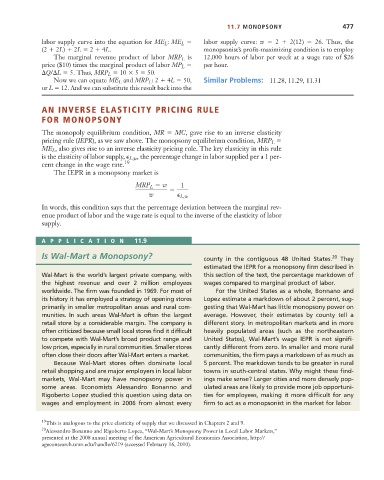Page 503 - Microeconomics, Fourth Edition
P. 503
c11monopolyandmonopsony.qxd 7/14/10 7:58 PM Page 477
11.7 MONOPSONY 477
labor supply curve into the equation for ME L : ME L labor supply curve: w 2 2(12) 26. Thus, the
(2 2L) 2L 2 4L. monopsonist’s profit-maximizing condition is to employ
The marginal revenue product of labor MRP L is 12,000 hours of labor per week at a wage rate of $26
price ($10) times the marginal product of labor MP L per hour.
Q/ L 5. Thus, MRP L 10 5 50.
Now we can equate ME L and MRP L : 2 4L 50, Similar Problems: 11.28, 11.29, 11.31
or L 12. And we can substitute this result back into the
AN INVERSE ELASTICITY PRICING RULE
FOR MONOPSONY
The monopoly equilibrium condition, MR MC, gave rise to an inverse elasticity
pricing rule (IEPR), as we saw above. The monopsony equilibrium condition, MRP
L
ME , also gives rise to an inverse elasticity pricing rule. The key elasticity in this rule
L
is the elasticity of labor supply, L,w , the percentage change in labor supplied per a 1 per-
cent change in the wage rate. 19
The IEPR in a monopsony market is
MRP w 1
L
w L,w
In words, this condition says that the percentage deviation between the marginal rev-
enue product of labor and the wage rate is equal to the inverse of the elasticity of labor
supply.
APPLICA TION 11.9
Is Wal-Mart a Monopsony? county in the contiguous 48 United States. 20 They
estimated the IEPR for a monopsony firm described in
Wal-Mart is the world’s largest private company, with this section of the text, the percentage markdown of
the highest revenue and over 2 million employees wages compared to marginal product of labor.
worldwide. The firm was founded in 1969. For most of For the United States as a whole, Bonnano and
its history it has employed a strategy of opening stores Lopez estimate a markdown of about 2 percent, sug-
primarily in smaller metropolitan areas and rural com- gesting that Wal-Mart has little monopsony power on
munities. In such areas Wal-Mart is often the largest average. However, their estimates by county tell a
retail store by a considerable margin. The company is different story. In metropolitan markets and in more
often criticized because small local stores find it difficult heavily populated areas (such as the northeastern
to compete with Wal-Mart’s broad product range and United States), Wal-Mart’s wage IEPR is not signifi-
low prices, especially in rural communities. Smaller stores cantly different from zero. In smaller and more rural
often close their doors after Wal-Mart enters a market. communities, the firm pays a markdown of as much as
Because Wal-Mart stores often dominate local 5 percent. The markdown tends to be greater in rural
retail shopping and are major employers in local labor towns in south-central states. Why might these find-
markets, Wal-Mart may have monopsony power in ings make sense? Larger cities and more densely pop-
some areas. Economists Alessandro Bonanno and ulated areas are likely to provide more job opportuni-
Rigoberto Lopez studied this question using data on ties for employees, making it more difficult for any
wages and employment in 2006 from almost every firm to act as a monopsonist in the market for labor.
19 This is analogous to the price elasticity of supply that we discussed in Chapters 2 and 9.
20 Alessandro Bonanno and Rigoberto Lopez, “Wal-Mart’s Monopsony Power in Local Labor Markets,”
presented at the 2008 annual meeting of the American Agricultural Economics Association, http://
ageconsearch.umn.edu/handle/6219 (accessed February 16, 2010).

